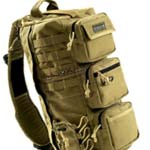Reader Question:
A reader wrote in asking: I’m just getting into prepping and wanted to know how often I should inspect and go through my gear?
Preparedness is something that you can never forget about. Even after you’ve an established a good supply of emergency preparations, you still need to periodically reassess your situation and your supplies. In fact, we advise going through your supplies at least once every 3-6 months. This will ensure everything is in good working order and ready to go should you need it.
Four things you should be doing to ensure your gear’s always ready to go.
 Rotation
Rotation
If at all possible you should be rotating your supplies into your normal everyday life. For instance, if you’re storing emergency food and water, they should be rotated into your normal eating patterns.
Far too many preppers make the mistake of not using their emergency stockpiles. In my opinion, there’s no need to waste good money stocking up on food that you’ll never use. By stocking up on foods that you already eat, and then rotating them into your normal diet, you will ensure that you not only have fresh food when a disaster hits, but you’ll also be saving a huge amount of money by not throwing away expired food.
 Gear Checks
Gear Checks
Over time, all gear will eventually break down and corrode. In order to make you’re your gear is in optimal working condition, you need to take time to perform routine maintenance on your supplies.
From cleaning and oiling your guns and knives, to making sure your lighters still have fluid, maintenance is something that needs to be factored into any good preparedness plan.
 Seasonal Checks & Swap Outs
Seasonal Checks & Swap Outs
Depending on the time of year, the type of gear you carry is not always going to be the same. This is especially true when putting together a bug out bag.
Unless you have a bag for each specific season, you want to go through your gear and make sure it’s designed for that specific time of year. There’s no reason to have a bag full of winter clothing when it’s 90 degrees outside.
 Planning
Planning
Another important part of being prepared includes periodically reassessing your plans based on the most up-to-date information and intelligence. From new threats that need to be taken into account, to route changes that could affect your evacuation plans, it’s always a good idea to make sure your emergency planning is up-to-date.



3 – 6 months….baa…listen people use your gear every day that the only way to know what works an what you gotta throw away a survivor a true survivor knows every day is what it take to just live in this world…by using your gear daily you come to understand how the gear wears and if its reliable most of my gear is better then 30 years old and it preform most excellently..I’ve brought new thing an found they were good for nothing an tossed them…only under heavy use will you know if the thing work and are worth keeping …THE MORE YOU KNOW THE LESS YOU WILL HAVE TO CARRY….Over 38 years of experience of surviving in this cursed world…..my gear works
I think the trap I fell into was that what we have stored, we don’t normal use a alot of, whole wheat berries. This will last a long time, but, unless we have hard times? Its not likely we will use much of this. Found a local coop and they will order any bulk food in for us at only 10% over their cost. 50lb sack of hard wheat cost $33.00 I couldnt pass it up… I have worked with it and realized that real wheat ground up is hard on most GMO systems. you have to drink more fluids with this type of wheat and your body struggles to get used to it at first.
for years I’ve stocked food up and I have gone through it and eaten it as a rotation…I try to keep a years supply on hand at any given time I see no sence in stocking 5 or 10 years of it…I personally found it hard to use up that amount over time…instead relying on a balance of food and gear as with weapon… knowledge plays more into surviving then any thing this has been learned threw trial and error…as with much of my gear..I seen new comers to the ways of the survivor and my buddy go out and buy a back pack and stuff it with all this newfangled gear and think that they are ready…this stuff is still in the package that china sold it in…and when they go afield with me they fine that 90% of they’re gear is useless or even broken right out of the package…open those package remove the items and put it to uses if its broke keep the piece that’s can be of use an toss the rest learn how to fix thing that are broken…one of the items in my pack is a mini tool kit I put it together from pieces over the years..and it serves me well in repairs afield.. my pack get use daily …from one thing or another..yes I rely on batteries but they don’t last long enough to caroide they are drained and discarded…yes I carry a 10 day supply of food in my pack and over a 3 -4 week period it gets eaten..38 years of experience has taught me what to carry in my pack ((( and they do get heavy )) water,food,fire and shelter is what should be in the pack nothing more the rest is luxury.the rifle you carry in your hands……every weekend you will fine me in the woods I don’t preach I practice all the skills of the woodsman tracking hunting fishing signs of all kinds..where to find the water the game how the weather folds where to put the camp when to move it…all this doomsday preppers have only pop up over the last couple of years…I’ve been a survivalist since i was 12 years of age and i am pushing 50 now as for you young people know this I am as strong now as ever with the knowledge and experience to back my ass up
Carry….fire is the most valuable thing to carry in your pack ..the more ways you have to start it the better off you are…from a simple bic lighter to a bow drill set..I carry several way personally..yes a bic lighter,a ferl rod, a couple magnesium bars w/ stricker rod on them..small candles, cotton ball and a small can of mink oil some people use Vaseline but the mink oil has several uses from chapped lips to water proofing you can also use it as a candling source, also in my fire kit there’s a magnifying glass, cotton string,to use w/ the mink oil as a wick, weather proof matches, a ball of steel wool people say you need a battery to start the steel wool but a ferl rod will ignite it even in the rain….a zippo lighter w/ a small can of fuel an flints.two can of Sterno w/ up to 6 hrs. of burn time…and last but not least and old fashen flint an steel striker w/ char cloth in it little tin ..my favorite way personally…one has to understand the complexity of fire it has to be cared for sheltered like a baby tended and feed or it will die on you …fire is a living creature it consume and destroys ..it can save your life or take your life just as easy..its the survivors first defense against the elements this is just one piece of the puzzle the things you have to learn……water is the next piece…with out them both mother earth will take you…the rest is all around you you just gotta know where to look…..STOP LOOK & LISTEN…stay hidden stay quite and stay alive what ever it takes….
those are all good points that you bolth have made I’ve always been a survivalist and thought ahead what to stock up on and to keep with me when I’m in the woods or even when i was in Iraq some of us youngens are just younger
Depends on the supply category…
Gear gets checked out every month on a camping trip, rain, snow, sunny, cloudy, cold, hot… does not matter; we go camping in The Rockies at least one weekend every month.
BOB is a duplicated set of camping gear in a Gregory Palisades backpack with full-time four-season capability always… Since there is never knowing when or for how long, the need to leave and survive during all of the four seasons has to be covered. If any gear needs an upgrade as discovered during a camp trip, it gets replaced accordingly.
Food supplies… if it is approaching the expiration date it gets used on a camping trip and resupplied with fresh at the back of the rotation.
Fuel is rotated weekly using six 5-gallon gas cans… just pour the oldest into the tank before going to the gas station, fill the can first and then the tank… put the fresh gas can at the back of the rotation. This ensures I have over a 750-mile capability at any time as long as tank is not below half. Only add stabilizer ‘after’ any SHTF situation.
There’s a good number of preppers – especially suburban ones – who have a bag full of gear they’ve never used before ready to go in the closet. That’s a pretty severe invitation to failure.
It’s all about dry runs. Take your BOB and run off for a weekend with only that stuff (like Mike says, camping trips). Flip off the electricity and water at home for another weekend and see how it goes. You don’t need to schedule gear checks and so forth, you need to schedule tests so that you can validate your planning and stockpile against the real world.
A big part of prepping or beang a survivalist is to check out your gear be that big geeky kid who plays with all the survival toys and test out prepper storage ideas learn sharpen the mind with weapons safety classes and run drills for first aid repatition repatition repatitionthe better you train yourself and your familythe better your chances are that you and your family will be a part of those who will be alive to see another day and in the end that all that matters
Canned goods will last for a very, very long time. There was a miltiary study ( sorry no link) done to determine the shelf life of canned goods. they opened a 40 year old can of green beans and it looked and tasted like it should. The vitamin cosistency was almost gone though. So, calories yeah…..nutrition no. So take a multi-vitiamin with it. Vacuum pak pasta and dry beans. They will last for 25 years in a cooler environment. Rotation is not necessary for survival.